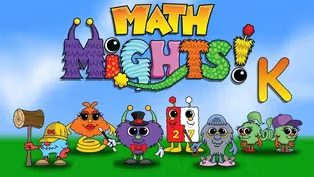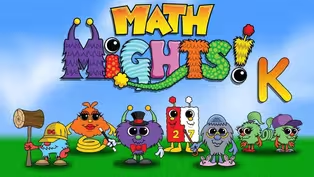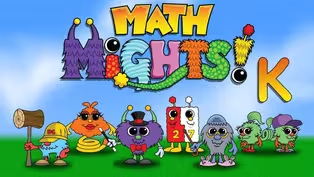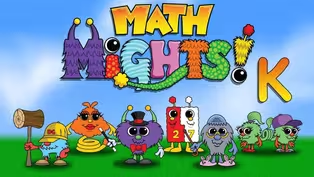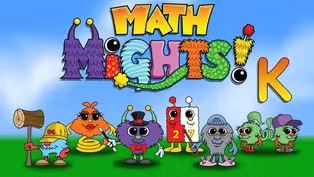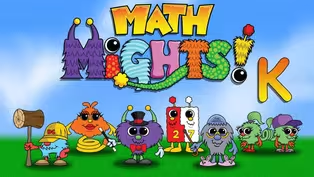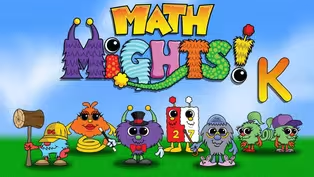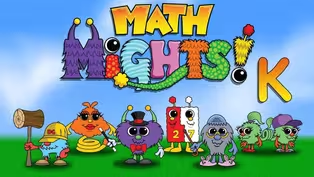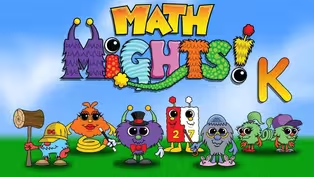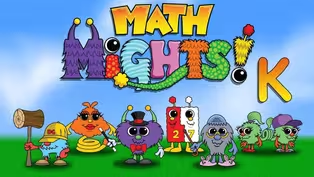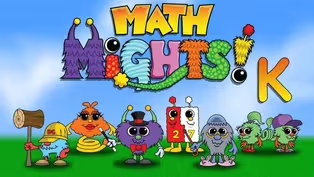Math Mights
Break Apart Numbers to 5
Season 3 Episode 303 | 15m 59sVideo has Closed Captions
Join Mrs. Gray for a word problem with Professor Barble!
Join Mrs. Gray for a word problem with Professor Barble! Next get your mallet ready to decompose and compose numbers up to 5 with D.C.
Problems playing video? | Closed Captioning Feedback
Problems playing video? | Closed Captioning Feedback
Math Mights is a local public television program presented by Detroit PBS
Math Mights
Break Apart Numbers to 5
Season 3 Episode 303 | 15m 59sVideo has Closed Captions
Join Mrs. Gray for a word problem with Professor Barble! Next get your mallet ready to decompose and compose numbers up to 5 with D.C.
Problems playing video? | Closed Captioning Feedback
How to Watch Math Mights
Math Mights is available to stream on pbs.org and the free PBS App, available on iPhone, Apple TV, Android TV, Android smartphones, Amazon Fire TV, Amazon Fire Tablet, Roku, Samsung Smart TV, and Vizio.
Providing Support for PBS.org
Learn Moreabout PBS online sponsorshipMore from This Collection
Video has Closed Captions
Join Mrs. Gray for a subtraction word problem with Porfessor Barble! (15m 52s)
Video has Closed Captions
Join Mrs. Gray for a subtraction word problem with Porfessor Barble! (15m 59s)
Video has Closed Captions
Join Mrs. Gray for a subtraction word problem with Professor Barble! (15m 59s)
Video has Closed Captions
Join Mrs. Gray for a subtraction word problem with Professor Barble! (15m 59s)
Compose & Decompose Numbers to 9
Video has Closed Captions
Join Mrs. Gray for a word problem with Professor Barble! (16m 1s)
Break apart pattern block designs
Video has Closed Captions
Join Mrs. Gray for a word problem with Professor Barble! (15m 59s)
Addition & Subtraction Expressions
Video has Closed Captions
Match fun story problems with the correct addition or subtraction expression. (16m 15s)
Video has Closed Captions
Join Mrs. Gray for a word problem with Professor Barble! (15m 59s)
Subtraction with Word Problems Part 2
Video has Closed Captions
Join Mrs. Gray & Dotson for a Numeracy Talk with My Counting Buddy Junior! (16m)
Video has Closed Captions
Join Mrs. Gray & Dotson to talk about numbers with My Counting Buddy Junior! (16m)
Addition Word Problems with Quick Draws
Video has Closed Captions
Join Mrs. Gray for Numeracy Talk with Dotson working on conservation to 10. (16m)
Providing Support for PBS.org
Learn Moreabout PBS online sponsorship(playful music) (sparkling sound) - Hi, kindergarten Math Mights.
My name is Mrs. Gray.
I'm so glad you came here to do some math with me today.
Today, we are gonna be doing a word problem with our friend Professor Barble.
We're also going to be learning how to break apart numbers.
Get ready, we're gonna meet our friend Professor Barble.
Professor Barble is an adventurer.
He wears a hat and his hat is his thinking cap.
On the top of his thinking cap comes a big pole out the top and on the top of the pole, there are four arrows.
Those four arrows help remind Professor Barble that when he comes to a word problem, he needs to stop and he needs to think about which direction to go with his word problem.
Let's take a look at our story problem that we're going to do today.
This is our story problem mat and on the mat is where we're going to be doing our work.
Let's look closely at the question that Professor Barble has for us.
Sam has three skateboards.
His brother has two skateboards.
How many skateboards does he have in all?
Remember, Professor Barble always wants us to stop and think about the problem before we try to solve it.
So the first thing we're gonna do is we're going to read the problem.
I'm gonna read it first and then I want you to say it after me.
Sam has three skateboards.
Now it's your turn to say it.
Sam has three skateboards.
Now we're gonna add our chunk because we just learned a piece of information.
Let's keep going in the story.
His brother has two skateboards.
Can you say it with me?
His brother has two skateboards.
We're gonna add our next chunk in our problem.
How many skateboards do they have in all?
Now you say it.
How many skateboards do they have in all?
We're gonna add our last chunk.
There are three pieces of information in our problem.
Now we're gonna look at the sentence form for our problem.
It says Sam and his brother have hmm skateboards.
In our sentence problem, whenever we see the line, we say hmm because right now, we don't know the answer that we're gonna add into the sentence later.
Let's take a look down at our mat.
We're gonna be building our story problem using some chips.
Sam had three skateboards.
Let's add them on our mat.
One, two, three, his brother had two skateboards.
Let's add them and I'm gonna make those ones yellow.
One, two.
If Sam had three skateboards and his brother had two, let's count how many they had all together.
One, two, three, four, five.
They had five skateboards.
Now we're gonna take what we did on our work mat and we're gonna do our quick draw that will match our story.
Sam had three skateboards.
One, two, three.
His brother had two, let's add them on our mat.
One, two, remember, when we do a quick draw, it's just a quick picture.
So I'm not gonna spend time doing actual skateboards.
I just made quick circles.
Now after that, we're gonna build it on our 10 frame.
We're gonna show the three skateboards that Sam had and we're gonna fill in the two skateboards that his brother had.
Together, they had five skateboards.
I know this because this is a 10 frame and that means there's five boxes on the top so I don't even need to count them.
Now let's take what we've learned and try to put it down in our number bond.
We had three skateboards for Sam and we had two skateboards for his brother.
I know if I have three and two and I put them together, that means they had five skateboards.
Now let's keep going and we're gonna write the expression that matches our number bond.
Down here, we would write three plus two equals five.
I knew that was an addition problem because they got more.
They took the three and they took the two and we put them together so we know that it has to be an addition problem cause we didn't take any of them away.
At the top, here is our sentence form again.
This is where we had the hmm line that we need to fill in.
It says Sam and his brother had hmm skateboards.
Well, I know that they have five skateboards together because of all the work that we've done.
You have done a great job helping me get through our first word problem.
Professor Barble I think would be very proud of how we stopped and we thought about the problem before we even started.
Let's take a look at our I can statement for today.
I can compose and decompose numbers up to five.
I want you to take a close look at these two pictures.
In both of these boxes, I have some diamonds.
Look at these diamonds.
What do you notice about the two pictures?
What did the two pictures make you wonder?
Well, I have some new friends here today that also looked at those pictures.
Let's meet them.
Brianna and Hana both looked at the pictures.
When they looked at the pictures, Brianna noticed that in both boxes, there were five shapes in each box.
Both of the boxes were filled with diamonds as well.
Hana noticed that in the first box, there were the diamonds and in the second box, there was a space in the middle of the diamonds.
I wonder what they wondered about.
Brianna wondered about how many shapes were in each box and our friend Hana, she wondered why is there a space in the middle on the second box?
What did you notice?
What did you wonder when we were looking at the pictures?
Let's keep going and see what we can figure out.
Down here on my board, I have the two pictures.
Here are the diamonds from the first picture and here are the diamonds from the second picture.
When I looked at these diamonds, it made me think of different expressions that we could write that would match the picture.
Let's take a closer look at the first drawing.
In the first drawing, I noticed there were diamonds.
Can you count them with me?
One, two, three, four, five, there were five diamonds.
We can write an expression to show an addition problem that would match that picture.
Five plus zero because we didn't add any more diamonds onto that.
And when we take five and we take zero and we put it together, that means that we had five.
Five plus zero equals five.
In the second picture, I noticed the space that Hana noticed.
Let's take a closer look on each side of that space.
On the first side, can you count them with me?
One, two, three.
There were three diamonds on the first side.
Let's take a closer look at the other side of the space.
Count them with me.
One, two, we can also make an addition problem because we had three plus two equals, now let's count them altogether.
Count with me.
One, two, three, four, five.
Three plus two equals five.
Wow, well, we're gonna be doing some more stuff by looking at two pictures.
We're gonna be doing lots of adding, so get ready.
Now we're gonna do another problem using a linking cube train activity.
In this train activity, I'm gonna be using the linking cubes and break them into two pieces.
Let's take a look.
I have five linking cubes, count with me.
One, two, three, four, five.
I'm gonna take them and I'm going to break it into two pieces.
I'm gonna put this piece in the bowl and this piece out on the board.
Now using our two pieces, we're gonna try to make a number bond that would match the pieces of our train.
On the first piece of the train, there are three cubes.
Count them, one, two, three.
We're gonna put that number in our number bond.
Now, look at the cubes that I have in the bowl.
There are two cubes, one, two.
We're gonna take that number and put it in our number bond.
When I had three and two with our train, I am able to take the numbers and put them together and we know that three and two make five.
Let's add it on our number bond.
Three and two makes five.
We can also go ahead and add our number expression to go with it.
Let's add it, three plus two equals five.
You did an excellent job with that last one.
Now let's do another number train using our linking cubes.
Here are my five linking cubes.
I am gonna break it in a different spot.
On the board, there are four linking cubes.
We're gonna add that number in our number bond.
There was four in the first piece of the train.
On the second piece of the train, there was just one linking cube.
Let's add that number in our number bond.
If I had four and I had one, when we put them together, that was the five from the beginning of our train.
Let's add it on our board.
Now let's try to write the number expression to go along with it.
Four plus one equals five.
Wow, Math Mights, you did a great job with that.
Now let's take a closer look at both of the number trains that we had.
Hana has some ideas of things that she noticed when she looked at those trains.
Hana said that she noticed the total number of cubes stayed the same with both of the trains.
Let's take a closer look at what Hana saw.
Hana noticed that both trains were five even though when they were broke apart, they had different numbers in each of their train pieces.
Did you notice the same thing that Hana noticed or maybe you saw something different?
You have been doing a great job with helping me take apart and decompose numbers.
Now we're gonna keep practicing by playing a game called Five Frame Shake.
To play this game, we will be using our five frame mat, our five frame shape recording sheet, a red and yellow colored pencil and some red and yellow counters.
Get ready, we're gonna have some fun.
To play the game, I'm gonna start shaking the cup and spill it onto the table.
Looking at our chips, I'm gonna organize them into my five frame.
I had one red and four yellow.
On the recording sheet, I'm gonna color the picture to match.
Next, we're going to write the expression to go along with it.
One for the one red plus four for the four yellow equals five.
Now we can add it into our number bond.
We had one and four and when we put them together, it made the five.
We had such a great time playing Five Frame Shake.
I bet you would like to try to play it too with a friend.
You're gonna get a chance to play it.
We had such a great time today.
I am so proud of how we learned to do math together.
I can't wait to see you soon.
(playful music) - [Boy] Sis4teachers.org.
- [Girl] Changing the way you think about math.
- [Woman] This program is made possible with funding from the Michigan Department of Education, Governor's Education Emergency Funds, the state of Michigan, and by viewers like you.


- Home and How To

Hit the road in a classic car for a tour through Great Britain with two antiques experts.










Careers that Work

Support for PBS provided by:
Math Mights is a local public television program presented by Detroit PBS
